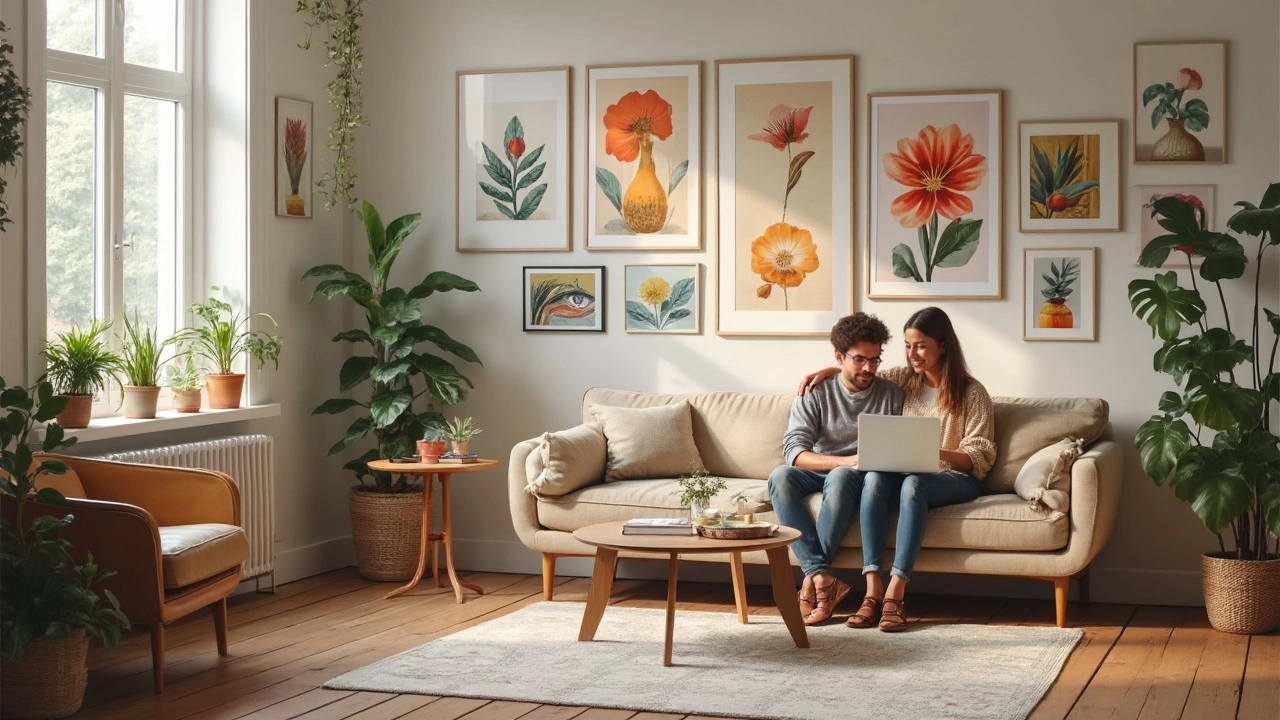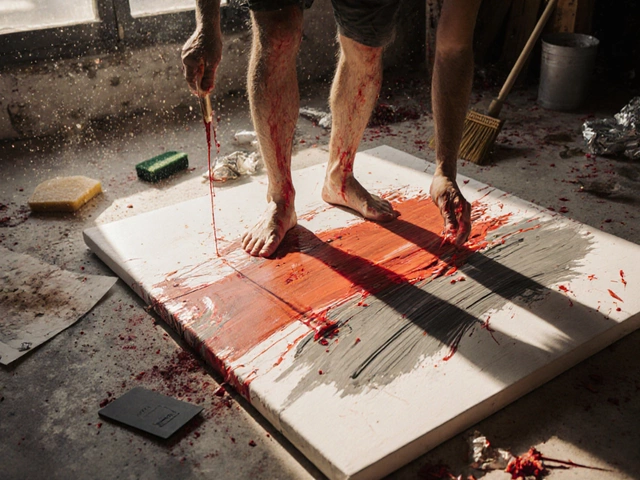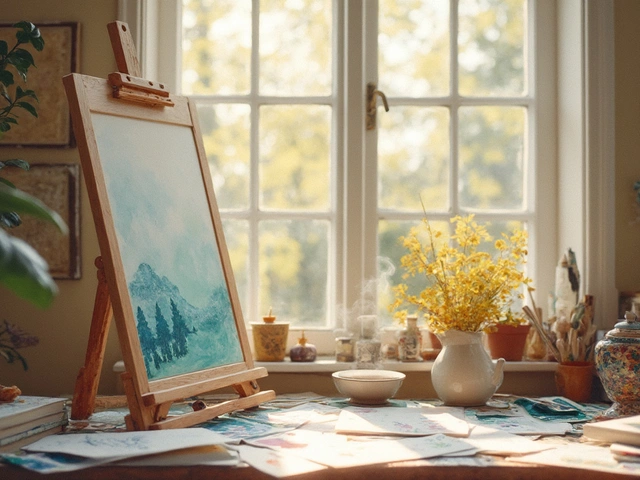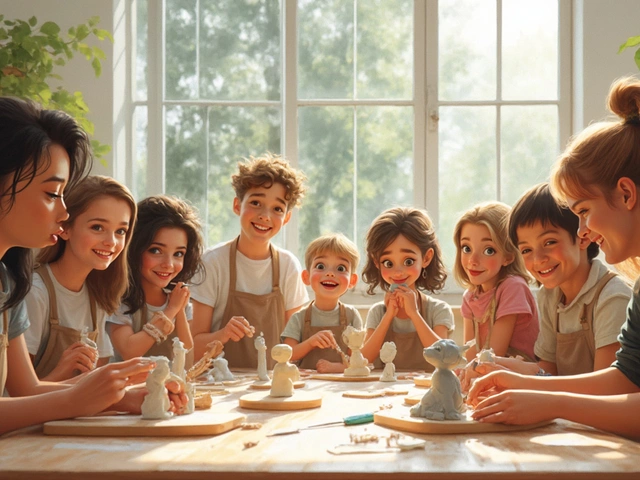Walk into any home goods store, scroll through Instagram, or check Etsy’s trending lists—art prints pop up everywhere. If you’re looking to make art that actually sells, prints are hands-down the top dog on most platforms. Why? They’re affordable, easy to ship, and buyers love swapping them out as their taste changes.
But not all prints are created equal. Some styles and subjects have way more pulling power than others. Minimalist abstracts, bold graphic designs, botanical illustrations, and pop culture references usually disappear from shelves fast. Practical tip: if you're making prints, keep an eye on color trends and what’s catching people’s eyes on social—that stuff sells.
It isn’t just about what you print, though. Smart packaging, quality paper, and extra touches like including a small thank you card can turn a casual buyer into a repeat customer. If you want to get your art actually hanging on someone’s wall, print size, paper feel, and vibrant colors matter a lot more than you’d think.
- What Makes Art Prints So Popular?
- Digital vs. Traditional Prints: What Sells Best?
- Buyer Behavior: Key Trends That Drive Print Sales
- Tips for Artists: How to Sell More Art Prints
What Makes Art Prints So Popular?
People love art prints for one main reason: you don't need a fat wallet to own great art. Prints turn what could be an expensive painting or drawing into something most folks can actually afford. Someone can deck out their whole apartment with cool designs and spend less than the cost of a single original painting.
Artists benefit, too. One original piece can only go to one buyer, but a print can be sold over and over. That means way more people can enjoy the same artwork, and the artist cashes in from multiple sales. No wonder so many artists, from well-known pros to hobbyists, jump on the art prints bandwagon.
There's also the whole problem of space and practicality. Prints are lighter, easier to frame, and way less hassle to ship worldwide. If you’ve ever seen how much it costs to ship a framed canvas overseas, prints start to look even better. Online stores like Etsy, Society6, and Redbubble make it super simple for both artists and buyers to connect over prints, fueling this massive market.
If we break it down, here’s what helps art prints win:
- Accessibility: Everyone can buy and enjoy art, not just big collectors.
- Affordability: Lower prices mean more sales and bigger audiences.
- Trendiness: People love switching up their decor and prints make it easy.
- Scalability for artists: Sell the same work multiple times, boosting your reach and income.
- Easy shipping: Prints roll up or slide into a flat mailer—no expensive freight needed.
Surveys from 2024 show that art prints outsell originals and canvases by a big margin online, making up around 60% of total art transactions on major marketplaces. Whether you’re an artist or a buyer, prints are just the most practical way to bring art into more lives.
Digital vs. Traditional Prints: What Sells Best?
If you’re trying to decide between digital and traditional art prints, it helps to know what’s moving fastest. Digital prints—think giclée and high-quality inkjet—are the big winners right now, especially on online shops. The main reason? Digital prints are easy for artists to produce in batches. You can offer more sizes and finishes without restocking every few weeks.
Platforms like Etsy, Redbubble, and Society6 make it super simple for artists to upload designs and sell to a global crowd. Buyers like the instant gratification and the lower price tags. For example, on Etsy alone, digital downloads and print-on-demand art have jumped in popularity, with thousands of new listings added every day.
| Print Type | Average Price Range | Popularity Online |
|---|---|---|
| Digital (Giclée, Inkjet) | $10–$50 | Very High |
| Traditional (Screenprint, Lithograph) | $40–$300+ | Lower (but niche fan base) |
Traditional prints like screen prints, woodcuts, and lithographs still have a loyal following. These attract collectors who care about hand-made touches and limited editions. They’re usually pricier because of the process and the "real person made this" vibe. But here’s the truth: the volume just doesn’t compare to digital. Traditional methods are labor-intensive; you can’t crank out 50 new prints in a weekend. So while they fetch higher prices, they don’t sell nearly as fast or in as high quantities as digital art prints.
If your goal is reaching as many buyers as possible and scaling up fast, digital wins by a mile. But if you’re going for a collector vibe and don’t mind smaller sales numbers, traditional prints still have a place—and a dedicated crowd willing to pay for them.

Buyer Behavior: Key Trends That Drive Print Sales
People buy art prints for a bunch of pretty straightforward reasons. Price is the number one driver. Most buyers don’t want to spend hundreds or thousands on original art, but they love the idea of a cool piece that changes the vibe in their space. Prints hit that sweet spot: good looks, affordable price tag.
Online marketplaces are where most of the action happens now. Sites like Etsy, Society6, and even Instagram shops make it dead simple to browse, order, and get stuff shipped to your door. Mobile shopping is huge—a 2024 report said over 65% of art prints under $100 were bought on a smartphone. Fast, easy checkouts and lots of payment options matter way more than you’d guess.
There’s also a clear pattern for what sells best. Here’s what’s topping the charts:
- Trendy Subjects: Think plant illustrations, city maps, and pop culture icons.
- Customizable Prints: Buyers love adding names, dates, or even picking color schemes for their print.
- Affordable Framing Options: Prints bundled with simple frames outsell unframed ones, especially for gifts.
- Instant Downloads: Digital files people print at home are flying off the virtual shelves. Zero shipping wait is a big plus for last-minute decorators.
Social proof is another big deal. Positive reviews, customer photos, and “trending” badges convince fence-sitters to hit buy. If you’re selling, reach out to happy customers and get them to share pics of your art prints in real-life rooms—those shots drive more sales than fancy product photos.
Check out this quick breakdown of what matters most for print buyers, based on a 2024 industry survey:
| Buying Factor | % of Buyers Prioritizing It |
|---|---|
| Price/Affordability | 78% |
| Easy Checkout | 65% |
| Trendy Design | 63% |
| Positive Reviews | 54% |
| Custom Options | 46% |
At the end of the day, if your art prints look good, are easy to buy, and don’t bust people’s budgets, you’ll move a lot more product. Listen to what buyers are into, and keep your eyes on review sections and social trends—they’ll tell you exactly what your next big seller could be.
Tips for Artists: How to Sell More Art Prints
If you want to boost your art prints sales, you’ll need more than just good artwork. It’s about making smart choices, handling business like a pro, and connecting with your audience.
First, your product has to stand out. That means using high-quality paper (think acid-free, heavy stock) and vivid inks. Cheaper options fade fast and feel flimsy in hand—buyers notice. Giclée printing is a favorite for collectors and shops like Society6 and Saatchi Art, because the prints keep colors true for years.
Packing matters more than most realize. Damaged prints are one of the main reasons for returns. Use plastic sleeves, rigid mailers, or even tubes for bigger pieces. Adding a “thank you” card or a small freebie (like a sticker) makes a stronger impression than the typical receipt.
Now let’s talk about your online shop. High-quality, natural-light photos of your prints hanging on real walls catch eyes way better than flat product scans. Give buyers close-ups of texture and show different framing options if you can. On Etsy, listings with at least three images sell about 20% better on average.
- Keep your shop up to date with trending subjects—popular right now: botanicals, minimal abstracts, and nostalgic pop culture themes.
- Use clear keywords like art prints, the exact style (e.g., “mid-century modern art print”), and popular colors in your product titles and tags.
- Offer multiple sizes—small, standard, and poster-sized prints let buyers pick what fits their space and budget. About 60% of buyers on Etsy go for something bigger than A4 if the price jump isn’t huge.
- Respond to messages quickly. Quick replies seriously boost your chance of getting repeat business or closing a waffling buyer.
Smart promotion goes a long way. Don’t just drop your new print on your feed and hope for sales. Tease the launch with behind-the-scenes looks or share stories about your creative process. People are more likely to buy from artists they feel a personal connection with.
Social proof matters, too. Encourage happy buyers to post their prints in their homes and tag you—reshare those pics! It builds trust with new customers and shows your prints are loved in real homes.
Check out this quick comparison of popular print-selling platforms to help decide where to set up shop:
| Platform | Fee Structure | Audience Size |
|---|---|---|
| Etsy | 5% + listing fee | High (millions monthly) |
| Shopify | Monthly plus payment fee | Depends on your own traffic |
| Society6 | Base amount, artist sets markup | Wide, especially US/Europe |
The bottom line: stay flexible and keep connecting with your buyers. If something’s not selling, don’t be afraid to switch things up fast. Listen to your audience and don’t skimp on presentation. The artists doing best with art prints are the ones mixing quality, style, and smart marketing. You’ve got this.





